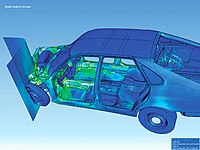
Photo from wikipedia
Finite element models of biomedical applications increasingly use anisotropic hyperelastic material formulations. Appropriate material parameters are essential for a reliable outcome of these simulations, which is why planar biaxial testing… Click to show full abstract
Finite element models of biomedical applications increasingly use anisotropic hyperelastic material formulations. Appropriate material parameters are essential for a reliable outcome of these simulations, which is why planar biaxial testing of soft biological tissues is gaining importance. However, much is still to be learned regarding the ideal methodology for performing this type of test and the subsequent parameter fitting procedure. This paper focuses on the effect of an unknown sample orientation or a mistake in the sample orientation in a planar biaxial test using rakes. To this end, finite element simulations were conducted with various degrees of misalignment. Variations to the test method and subsequent fitting procedures are compared and evaluated. For a perfectly aligned sample and for a slightly misaligned sample, the parameters of the Gasser-Ogden-Holzapfel model can be found to a reasonable accuracy using a planar biaxial test with rakes and a parameter fitting procedure that takes into account the boundary conditions. However, after a certain threshold of misalignment, reliable parameters can no longer be found. The level of this threshold seems to be material dependent. For a sample with unknown sample orientation, material parameters could theoretically be obtained by increasing the degrees of freedom along which test data is obtained, e.g. by adding the data of a rail shear test. However, in the situation and the material model studied here, the inhomogeneous boundary conditions of the test set-ups render it impossible to obtain the correct parameters, even when using the parameter fitting method that takes into account boundary conditions. To conclude, it is always important to carefully track the sample orientation during harvesting and preparation and to minimize the misalignment during mounting. For transversely isotropic samples with an unknown orientation, we advise against parameter fitting based on a planar biaxial test, even when combined with a rail shear test.
Journal Title: Journal of the mechanical behavior of biomedical materials
Year Published: 2018
Link to full text (if available)
Share on Social Media: Sign Up to like & get
recommendations!